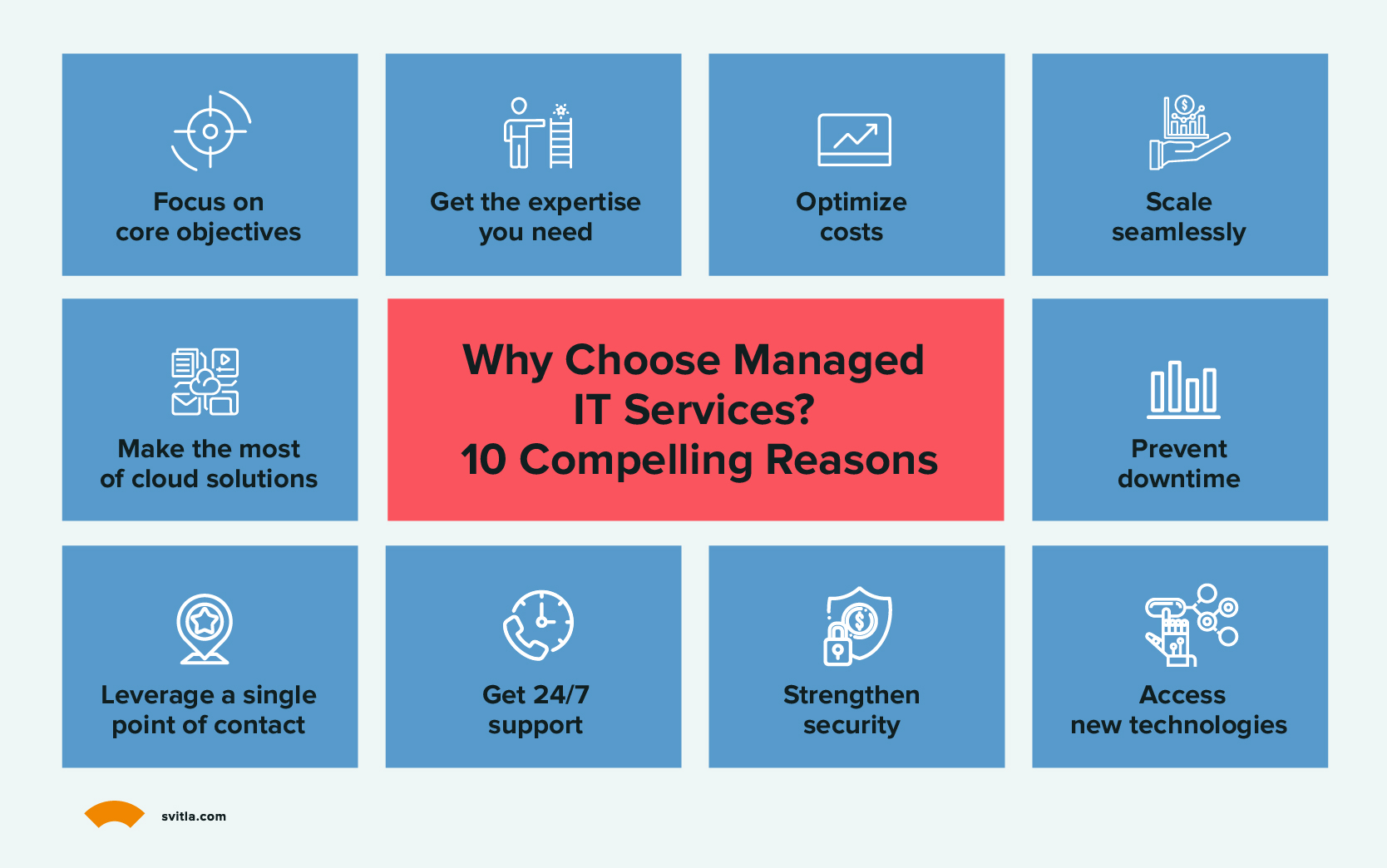Outsourcing and managed services are appealing options for many companies when the workforce is understaffed, and budgets are under pressure. Let's look deeper at each to fully understand the main difference, as these terms aren’t interchangeable and involve vastly different scopes of work.
The main point is that outsourcing covers a broad umbrella of IT tasks, including managed services as an outsourcing service type and engagement model. The managed services business model involves an external provider managing the entire service, delivering based on service level agreements, and often utilizing technology for enhanced performance.
In contrast to traditional outsourcing, managed services offer more complex and higher-value inputs like 24/7/365 maintenance and support. Both managed services and outsourcing involve hiring an external provider.
Outsourcing is a common practice in which a company hires an external provider to handle a specific task or function. The provider is responsible for delivering the service, and the company typically pays pre-agreed rates or a fixed fee. Outsourcing can be a cost-effective option for businesses that need to complete a project or task outside their core competencies, desire not to have critical internal resources involved in supporting legacy applications, or are looking at moving internal headcount to other mission-critical applications while outsourcing noncritical application development and support.
A managed services approach can be considered more comprehensive to IT and business needs. When requesting managed service assistance, a company hires an external provider to operate and maintain its IT assets, including applications, infrastructure, and business functions like end users. The provider is responsible for ongoing support, maintenance, proactive monitoring, and management to avoid recurring issues. This service can be a cost-effective option for businesses needing ongoing support and maintenance for their IT environments but needing more resources to help manage in-house.
By the end of this article, you’ll understand how Svitla Systems provides managed services activities and the right time to approach such a Managed Services Provider (MSP) to develop a custom solution for your needs.
When to Use Managed Support Services for Your Organization
During any business's growth stages, there are turning points when new technologies and processes are needed to support the company’s development. But which is the first sign of this need that many companies experience?
Surely, strong evidence is the inability of in-house IT teams to keep pace with the changing business environment bringing new requirements and demands for IT solutions. For that reason, many firms rely on managed service providers to provide greater support for their business growth by designing a custom and flexible IT solution.
Understanding what situations could guide you to managed services assistance is relatively easy. Here are a few cases that indicate you might benefit from managed services:
- Not enough capacity to handle 24/7/365 support activities
- Overloaded core team unable to operate and innovate at the same time
- Weak performance metrics from the current support team
- Failing to meet the IT budget value proposition
- Costly downtime risks
- Poor user experience because of weak support and/or unavailable applications
The rise in popularity of managed services comes as no surprise, as the benefits of this delivery model are multifold. Managed services can take over parts of clients' operations or the entire process, including all its elements that are complex, time-consuming, cumulative, and dependent on external data. It’s precisely the MSPs like Svitla Systems that take on the responsibility of investing in people, know-how, and technology, which allow their clients to devote their time, money, and attention to their core business.

Benefits of Using Managed Services in IT
Cost savings
These services are much lower in cost than retaining the number of full-time staff members required to complete the same projects efficiently. How? By leveraging offshore and nearshore resourcing labor pools.
Increased productivity
Working with an MSP means that the tasks the service provider manages will no longer be assigned to internal staff. Logically, the in-house staff can concentrate on high-priority projects and launch innovations faster and more successfully.
Improved business continuity
Downtime is costly since it can damage your reputation and cause lost deals during the lapse. With proactive steps to managed services, your company can decrease downtime. If there is an issue, such as a disaster recovery case, your MSP can get you back up quickly.
Specific expertise
An MSP can provide the right expertise for the specific technology field. As a result, your company can be versatile in terms of the types of projects and processes it can launch and maintain.
Managed Services at Svitla Systems
In addition to the benefits stated above, Svitla Systems offers additional ones, such as long-term cooperation, engagement flexibility, a global follow-the-sun footprint, and best-of-class deliveries. Svitla’s managed support team works under the same standards and best practices clients establish for their teams.
Doing so means clients can rely on our support professionals 24/7/365 and expect long-term and valuable support cooperation facilitated by shared governance and continuous improvement.
Svitla encourages customers to influence support team behaviors to ensure they fit into their culture. We work from the client’s runbooks, operational procedures, and escalation paths while reporting results according to agreed-upon service-level agreements (SLAs). We approach every support engagement – big or small – with the same level of care and professionalism. We work with our clients every step of the way, offering them high-quality and cost-effective solutions.
Here’s an example of the managed services we provide:
- Applications support (monitoring, reporting, updates, etc.)
- Cloud services (IaaS, PaaS, SaaS)
- Database and data analytics systems (databases, data warehouses, Big Data storage)
- Dev/Ops and Site Reliability Support
- Cybersecurity solutions
Manages Services in Use – Engagement Drilldown Example
The most consistent and evident example of managed support activities, taken by your MSP, is assistance on the tech support side.
Technical support is an essential function for every international managed services company since they provide their services remotely and in different parts of the world.
It’s a good idea to delegate this activity to an MSP in most cases. In this case, our long-term client, a multinational pharmaceutical and biotechnology company, best known for its involvement in developing the COVID-19 vaccine, approached Svitla with requests that required the active involvement of managed services:
- Enhance the capacity of existing support teams for internal web applications and reduce the workload of L3 support teams, allowing them to concentrate on critical tasks.
- Improve the operations between the L1 and L2 support teams to optimize the cost of managing support for multiple research solutions.
We approached this project by gathering all the necessary information from the client, detailing all processes, and presenting a brief overview of an internal candidate pool. Like a follow-up step, we researched the tools and methods for the client’s focus areas. Being always limited with time, we took the following steps:
- Conducted internal tech interviews to pick up the best senior-level experts;
- Presented candidates for the clients to interview to choose the ones who successfully will join the project.
- Exhibited transparency when creating team operational materials, establishing SLAs, and reporting our actual performance against plan plus remedies for any issues.
As a result of this project, the client's overall support costs were reduced, and the business problem was solved by fast and reliable responses to critical internal system errors. With managed services support from the Svitla Team, the client achieved this result within three months.
Takeaway
To ensure a clear understanding of managed services as part of outsourcing, ask yourself: Do you want to outsource a specific business process, or do you need extensive support managed by a skilled partner?
That’s the key difference and future company strategy to go with outsourcing or managed services assistance. Having found a clear answer, the next step will be to work with a company like Svitla to address painful places in technical processes step by step. Contact us to discuss your case and explore possible solutions with our team of consultants. Be sure to mention if you prefer a workshop setting.





![[Blog cover] SEO optimization best practices](https://svitla.com/wp-content/uploads/2025/05/Blog-cover-SEO-optimization-best-practices-560x310.jpg)